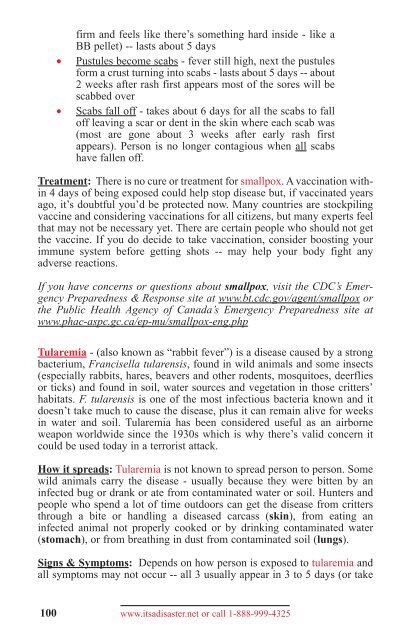disaster 5th 1108_5th ed 2011 - Homeland Security and Emergency ...
disaster 5th 1108_5th ed 2011 - Homeland Security and Emergency ...
disaster 5th 1108_5th ed 2011 - Homeland Security and Emergency ...
You also want an ePaper? Increase the reach of your titles
YUMPU automatically turns print PDFs into web optimized ePapers that Google loves.
firm <strong>and</strong> feels like there’s something hard inside - like a<br />
BB pellet) -- lasts about 5 days<br />
• Pustules become scabs - fever still high, next the pustules<br />
form a crust turning into scabs - lasts about 5 days -- about<br />
2 weeks after rash first appears most of the sores will be<br />
scabb<strong>ed</strong> over<br />
• Scabs fall off - takes about 6 days for all the scabs to fall<br />
off leaving a scar or dent in the skin where each scab was<br />
(most are gone about 3 weeks after early rash first<br />
appears). Person is no longer contagious when all scabs<br />
have fallen off.<br />
Treatment: There is no cure or treatment for smallpox. A vaccination within<br />
4 days of being expos<strong>ed</strong> could help stop disease but, if vaccinat<strong>ed</strong> years<br />
ago, it’s doubtful you’d be protect<strong>ed</strong> now. Many countries are stockpiling<br />
vaccine <strong>and</strong> considering vaccinations for all citizens, but many experts feel<br />
that may not be necessary yet. There are certain people who should not get<br />
the vaccine. If you do decide to take vaccination, consider boosting your<br />
immune system before getting shots -- may help your body fight any<br />
adverse reactions.<br />
If you have concerns or questions about smallpox, visit the CDC’s <strong>Emergency</strong><br />
Prepar<strong>ed</strong>ness & Response site at www.bt.cdc.gov/agent/smallpox or<br />
the Public Health Agency of Canada’s <strong>Emergency</strong> Prepar<strong>ed</strong>ness site at<br />
www.phac-aspc.gc.ca/ep-mu/smallpox-eng.php<br />
Tularemia - (also known as “rabbit fever”) is a disease caus<strong>ed</strong> by a strong<br />
bacterium, Francisella tularensis, found in wild animals <strong>and</strong> some insects<br />
(especially rabbits, hares, beavers <strong>and</strong> other rodents, mosquitoes, deerflies<br />
or ticks) <strong>and</strong> found in soil, water sources <strong>and</strong> vegetation in those critters’<br />
habitats. F. tularensis is one of the most infectious bacteria known <strong>and</strong> it<br />
doesn’t take much to cause the disease, plus it can remain alive for weeks<br />
in water <strong>and</strong> soil. Tularemia has been consider<strong>ed</strong> useful as an airborne<br />
weapon worldwide since the 1930s which is why there’s valid concern it<br />
could be us<strong>ed</strong> today in a terrorist attack.<br />
How it spreads: Tularemia is not known to spread person to person. Some<br />
wild animals carry the disease - usually because they were bitten by an<br />
infect<strong>ed</strong> bug or drank or ate from contaminat<strong>ed</strong> water or soil. Hunters <strong>and</strong><br />
people who spend a lot of time outdoors can get the disease from critters<br />
through a bite or h<strong>and</strong>ling a diseas<strong>ed</strong> carcass (skin), from eating an<br />
infect<strong>ed</strong> animal not properly cook<strong>ed</strong> or by drinking contaminat<strong>ed</strong> water<br />
(stomach), or from breathing in dust from contaminat<strong>ed</strong> soil (lungs).<br />
Signs & Symptoms: Depends on how person is expos<strong>ed</strong> to tularemia <strong>and</strong><br />
all symptoms may not occur -- all 3 usually appear in 3 to 5 days (or take<br />
100 www.itsa<strong>disaster</strong>.net or call 1-888-999-4325





